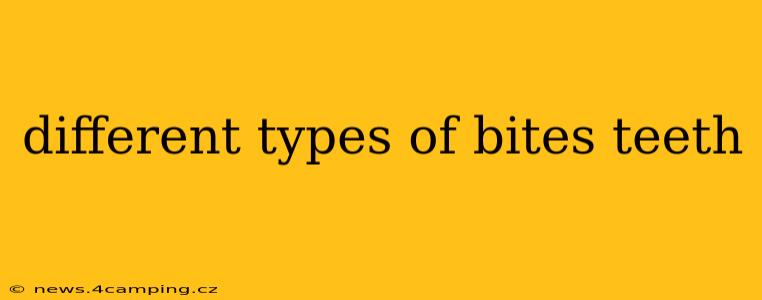Understanding your bite, or occlusion, is crucial for maintaining good oral health. The way your upper and lower teeth fit together significantly impacts your chewing efficiency, jaw joint health (TMJ), and overall facial structure. This article explores the different types of bites, their causes, and potential consequences.
What is a Normal Bite?
Before diving into the different types of malocclusions (abnormal bites), let's define a "normal" bite, also known as a Class I occlusion. In a Class I occlusion, the upper first molar sits directly behind the lower first molar. The upper incisors slightly overlap the lower incisors, creating a balanced and efficient bite.
Types of Abnormal Bites (Malocclusions)
Several types of abnormal bites exist, broadly categorized as Class II, Class III, and other variations.
Class II Malocclusion (Overbite)
In a Class II malocclusion, the upper jaw is positioned too far forward relative to the lower jaw. This often leads to an overjet (protrusion of the upper teeth) and can result in an overbite (upper teeth significantly overlapping the lower teeth). There are two subtypes:
- Class II Division 1: The upper central incisors protrude significantly.
- Class II Division 2: The upper central incisors are often retroclined (tilted backward), and the lateral incisors are protruded.
Causes of Class II Malocclusion: Genetics, thumb-sucking, tongue thrusting, and early loss of baby teeth can all contribute.
Class III Malocclusion (Underbite)
A Class III malocclusion is the opposite of Class II. The lower jaw is positioned too far forward, causing the lower teeth to overlap the upper teeth. This is often referred to as an underbite.
Causes of Class III Malocclusion: Genetics, premature loss of baby teeth, and certain medical conditions can play a role.
Open Bite
In an open bite, there's a gap between the upper and lower teeth when the jaws are closed. This can affect both the front and back teeth.
Causes of Open Bite: Thumb-sucking, tongue thrusting, and certain medical conditions can cause open bites.
Crossbite
A crossbite occurs when the upper teeth bite inside the lower teeth, instead of the typical overlapping pattern. This can affect either the front or back teeth, or both.
Causes of Crossbite: Narrow upper jaw, tongue thrusting, and premature loss of baby teeth.
Deep Bite
A deep bite is characterized by significant vertical overlap of the upper incisors over the lower incisors. This can sometimes lead to gum recession and problems with the temporomandibular joint (TMJ).
Causes of Deep Bite: Genetics and growth patterns.
How are Different Bite Types Diagnosed?
Diagnosis usually involves a comprehensive examination by a dentist or orthodontist. This includes a visual inspection of your teeth and jaw, along with X-rays and possibly models of your teeth.
What are the Treatments for Different Bite Types?
Treatment options vary depending on the severity and type of malocclusion. Options may include:
- Orthodontic treatment (braces): This is a common treatment for correcting misaligned teeth and jaws.
- Orthodontic appliances (expanders, retainers): These devices help to correct jaw discrepancies and maintain the corrected position of teeth.
- Surgery (in severe cases): Surgery may be necessary in some cases to correct severe jaw discrepancies.
What are the Long-Term Effects of Untreated Malocclusions?
Untreated malocclusions can lead to various problems, including:
- Difficulty chewing: Leading to digestive problems.
- TMJ disorders: Causing jaw pain and headaches.
- Increased risk of tooth decay and gum disease: Due to difficulty cleaning teeth.
- Speech impediments: In some cases.
- Aesthetic concerns: Affecting self-confidence.
Can a Bad Bite Affect My Child's Development?
Yes, a bad bite can potentially affect a child's development, influencing their speech, eating habits, and even their facial structure. Early intervention is crucial to prevent long-term problems. Regular dental checkups are recommended to identify and address potential issues early on.
This information is for educational purposes only and does not constitute medical advice. Always consult with a qualified dental professional for diagnosis and treatment of any dental or orthodontic concerns.
